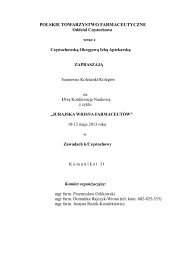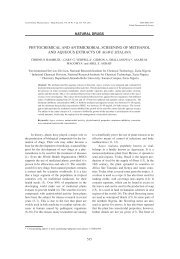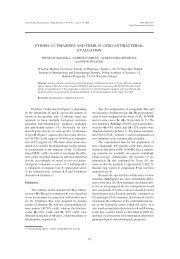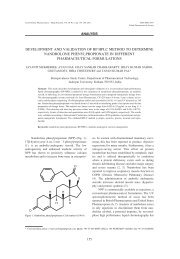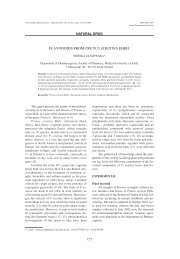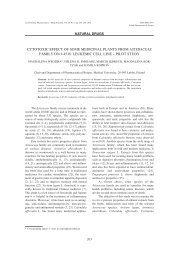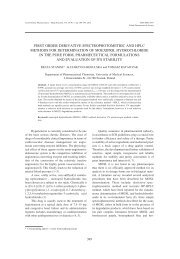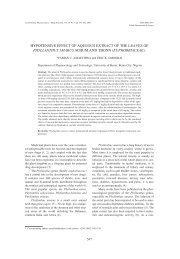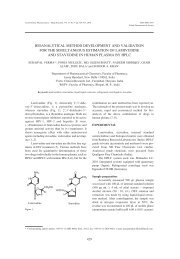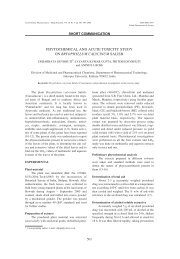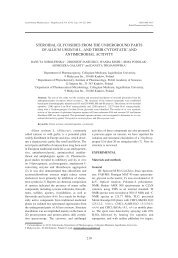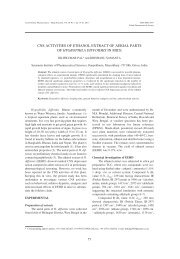analytical methods for residual solvents determination
analytical methods for residual solvents determination
analytical methods for residual solvents determination
Create successful ePaper yourself
Turn your PDF publications into a flip-book with our unique Google optimized e-Paper software.
Acta Poloniae Pharmaceutica ñ Drug Research, Vol. 67 No. 1 pp. 13ñ26, 2010 ISSN 0001-6837<br />
Polish Pharmaceutical Society<br />
ANALYTICAL METHODS FOR RESIDUAL SOLVENTS DETERMINATION<br />
IN PHARMACEUTICAL PRODUCTS<br />
KATARZYNA GRODOWSKA 1,2 * and ANDRZEJ PARCZEWSKI 1<br />
1<br />
Jagiellonian University, Faculty of Chemistry, Department of Analytical Chemistry, Ingardena 3, 30-060<br />
KrakÛw, Poland<br />
2<br />
Pliva KrakÛw S.A., Mogilska 80, 31-546 KrakÛw, Poland<br />
Abstract: Residual <strong>solvents</strong> (RS) are not desirable substances in the final pharmaceutical product and their<br />
acceptable limits have been published in pharmacopoeias and ICH guidelines. The intension of this paper was<br />
to review and discuss some of the current <strong>analytical</strong> procedures including gas chromatographic (GC) and other<br />
alternative techniques which are used <strong>for</strong> <strong>residual</strong> <strong>solvents</strong> <strong>determination</strong>. GC <strong>methods</strong> have been developed to<br />
monitor this kind of impurities routinely. The most popular techniques of sample introduction into the gas chromatograph<br />
include direct injection, static or dynamic headspace, solid-phase microextraction and single drop<br />
microextraction. Different separation techniques like two dimensional chromatography or multicapillary chromatography<br />
were compared with classical separation mode with use of single capillary column.<br />
Also alternative methodologies <strong>for</strong> <strong>residual</strong> <strong>solvents</strong> testing were discussed in this review. In conclusions, gas<br />
chromatography-based procedures were described as the most appropriate because of the lowest detection limits,<br />
ease of sample preparation and specificity.<br />
Keywords: <strong>residual</strong> <strong>solvents</strong>, <strong>analytical</strong> <strong>methods</strong>, gas chromatography, headspace, solid-phase microextraction,<br />
single drop microextraction<br />
Organic <strong>solvents</strong> are routinely applied during<br />
synthesis of drug substances, excipients, or during<br />
drug product <strong>for</strong>mulation. They are not desirable in<br />
the final product, mainly because of their toxicity,<br />
their influence on the quality of crystals of the drug<br />
substance and their odor or taste, which can be<br />
unpleasant <strong>for</strong> patients. To remove them, various<br />
manufacturing processes or techniques (usually under<br />
increased temperature or/and decreased pressure) are<br />
in use. Even after such processes, some <strong>solvents</strong> still<br />
remain, yet in small quantities. These small quantities<br />
of organic <strong>solvents</strong> are commonly known as organic<br />
volatile impurities (OVIs) or <strong>residual</strong> <strong>solvents</strong> (RS).<br />
The need to test and control <strong>for</strong> RS in pharmaceutical<br />
products was recognized in late 70ís. In this<br />
time, US Pharmacopoeia (USP XX) and Great<br />
Britain Pharmacopoeia (80 + add 82) put specific<br />
tests <strong>for</strong> RS in some monographs (1). The OVI test<br />
in USP was applied with no regard <strong>for</strong> the<br />
<strong>solvents</strong> used in manufacturing of pharmaceutical<br />
substances or drug products. This test was prepared<br />
<strong>for</strong> confirmation that benzene, methylene chloride,<br />
trichloroethylene, 1,4-dioxane and chloro<strong>for</strong>m are<br />
below maximum acceptable limits (2).<br />
In the early 80ís, the ìInternational Conference<br />
on Harmonization of Technical Requirements <strong>for</strong><br />
Registration of Pharmaceuticals <strong>for</strong> Human useî<br />
(ICH) was established. Then, in late 80ís, RS were<br />
classified as impurities. Categories of <strong>residual</strong> <strong>solvents</strong><br />
were presented in the preceding paper.<br />
The ICH Harmonized Guidelines set up by the<br />
EU, Japan and USA <strong>for</strong> the registration of pharmaceutical<br />
products require, under ICH Topic Q3C<br />
(published in December 1997), <strong>for</strong> ìtesting to be<br />
per<strong>for</strong>med <strong>for</strong> <strong>residual</strong> <strong>solvents</strong> when production or<br />
purification processes are known to result in the<br />
presence of such <strong>solvents</strong>î. These guidelines set criteria<br />
<strong>for</strong> <strong>analytical</strong> <strong>methods</strong> used to identify and<br />
quantify these <strong>residual</strong> <strong>solvents</strong> as well provide<br />
acceptable concentration limits. USP has finally<br />
adopted the ICH Q3C guidelines set and has revised<br />
its general <strong>methods</strong> to reflect it. The new general<br />
chapter states what ICH Q3C contains, and in addition<br />
describes <strong>analytical</strong> <strong>methods</strong> <strong>for</strong> per<strong>for</strong>ming RS<br />
testing. Limits and different <strong>methods</strong> <strong>for</strong> <strong>determination</strong><br />
of RS have been finally integrated in USP (1).<br />
Methods accepted by pharmacopoeias and ICH<br />
guidelines<br />
The first <strong>analytical</strong> method <strong>for</strong> RS, which was<br />
published in pharmacopoeias, was a loss of weight.<br />
This method could be carried out at normal pressure<br />
* Corresponding author: e-mail: kgrodowska@gmail.com<br />
13
14 KATARZYNA GRODOWSKA and ANDRZEJ PARCZEWSKI<br />
and/or under vacuum. The loss of weight is a simple<br />
and not demanding method, but apart from that it has<br />
many disadvantages, including lack of specificity,<br />
high limit of detection (about 0.1%), and also a relatively<br />
large amount of sample needed to per<strong>for</strong>m the<br />
tests (about 1 ñ 2 g). Moreover, atmospheric humidity<br />
can significantly modify the results obtained by<br />
the loss of weight method. Nowadays, <strong>for</strong> this kind<br />
of <strong>determination</strong>, more sophisticated techniques like<br />
thermogravimetric analysis (TGA), differential thermal<br />
analysis (DTA) or differential scanning<br />
calorimetry (DSC), which will be described more<br />
precisely in later paragraphs, can be used (3).<br />
Gas chromatography (GC), due to the volatility<br />
of organic <strong>solvents</strong> and the substantial separating<br />
capability of capillary columns, has dominated <strong>analytical</strong><br />
<strong>methods</strong> <strong>for</strong> RS <strong>determination</strong>s. It is no wonder,<br />
that pharmacopoeias also adopted this technique<br />
<strong>for</strong> RS <strong>determination</strong>. The <strong>methods</strong> and their<br />
usage are described in general chapters and in individual<br />
monographs.<br />
Current official <strong>methods</strong> <strong>for</strong> RS <strong>determination</strong><br />
are described in USP XXXI in chapter<br />
ìOrganic Volatile Impuritiesî. Under ìIdentification,<br />
control, and quantification of <strong>residual</strong> <strong>solvents</strong>î<br />
three procedures (A, B, C) <strong>for</strong> water-soluble<br />
and water-insoluble articles, are available.<br />
Procedures A and B are ìuseful to identify and<br />
quantify <strong>residual</strong> <strong>solvents</strong>, when the in<strong>for</strong>mation<br />
regarding which <strong>solvents</strong> are likely to be present in<br />
the material is not available.î In cases when we have<br />
in<strong>for</strong>mation about residues of <strong>solvents</strong> that may be<br />
expected in the tested material, only procedure C is<br />
needed <strong>for</strong> quantification of the amount of RS. All<br />
these <strong>methods</strong> exploit gas chromatography with capillary<br />
or wide-bore columns, static headspace injector,<br />
and flame ionization detector (FID). These procedures<br />
differ among themselves in column type<br />
(dimensions and film-coatings) and in chromatographic<br />
conditions. Sample preparation is also different<br />
<strong>for</strong> water-soluble and water-insoluble articles<br />
(4). The details concerning these general <strong>methods</strong><br />
used <strong>for</strong> <strong>residual</strong> solvent <strong>determination</strong>, are presented<br />
in Tables 1 and 2. In Table 2 three different headspace<br />
conditions are shown. USP does not specify<br />
which HS conditions should be chosen, but it<br />
depends on the solvent that was chosen <strong>for</strong> preparation<br />
of the sample (water or N,N-dimethyl<strong>for</strong>mamide),<br />
<strong>residual</strong> <strong>solvents</strong> under analysis (high or<br />
low boiling) and analyzed material (thermally stable<br />
or unstable).<br />
According to USP, <strong>determination</strong> of class 3 RS<br />
can be also done by loss on drying (USP <br />
Chapter), as long as the total loss on drying is less<br />
than the maximum acceptable limit <strong>for</strong> class 3 <strong>residual</strong><br />
<strong>solvents</strong> (5000 ppm).<br />
USP general procedures do not relate to specific<br />
<strong>solvents</strong>, but they try to compromise chromatographic<br />
and headspace conditions, in order to analyze<br />
all or the majority of organic <strong>solvents</strong> mentioned<br />
in chapter . In this chapter there are<br />
also four other <strong>methods</strong> (Method I, IV, V, VI) <strong>for</strong><br />
RS <strong>determination</strong> described. They concern <strong>determination</strong><br />
of chloro<strong>for</strong>m, 1,4-dioxane, methylene chloride<br />
and trichloroethylene, and they are suitable <strong>for</strong><br />
both water-soluble and water-insoluble drugs.<br />
Methods I, V and VI are based on direct injection,<br />
whereas Method IV describes the static headspace<br />
injection. Method VI is general, and it refers to the<br />
individual monographs which provide necessary<br />
in<strong>for</strong>mation about chromatographic conditions.<br />
Methods I, IV, V and VI were historically put in the<br />
USP earlier than procedures A, B, C. The main characteristics<br />
of <strong>methods</strong> I, IV, V and VI are summarized<br />
in Table 3 (4).<br />
In European Pharmacopoeia (EP), 6 th edition ,<br />
under chapter 2.4.24 ìIdentification and control of<br />
<strong>residual</strong> <strong>solvents</strong>î, general <strong>methods</strong> <strong>for</strong> <strong>residual</strong> solvent<br />
<strong>determination</strong> can also be found. Two procedures<br />
(systems), A and B, are presented, and<br />
ìSystem A is preferred whilst System B is employed<br />
normally <strong>for</strong> confirmation of identity.î Again, gas<br />
chromatography with headspace injection is proposed<br />
in both systems. Sample preparation relies on<br />
dissolution of 0.200 g of tested material in appropriate<br />
solvent, and diluting it to 20.0 mL with the same<br />
solvent. After that, 5.0 mL of such prepared solution<br />
is transferred to a headspace vial, filled with 1.0 mL<br />
of blank solution. For water-soluble samples, water<br />
is proposed as a solvent, <strong>for</strong> water-insoluble substances<br />
N,N-dimethyl<strong>for</strong>amide is recommended,<br />
and <strong>for</strong> samples where the presence of N,Ndimethylacetamide<br />
and/or N,N-dimethyl<strong>for</strong>mamide<br />
is suspected, 1,3-dimethyl-2-imidazolidinone (DMI)<br />
is suggested as a solvent. In system A, chromatographic<br />
and headspace conditions are the same as in<br />
procedure A (Table 1) <strong>for</strong> water-soluble articles in<br />
USP General Chapter. Also System B has its<br />
equivalent in USP: procedure B. In EP, as comprised<br />
with USP, a mass spectrometer (MS) or electron<br />
capture detector (ECD) have been additionally<br />
taken into account (apart from FID) (5).<br />
Generally, all <strong>methods</strong> <strong>for</strong> quantitative <strong>determination</strong><br />
of <strong>residual</strong> <strong>solvents</strong> taken from pharmacopoeias,<br />
need validation. For this reason, manufacturers<br />
try to find their own <strong>methods</strong> which would be<br />
(if possible) quicker, easier and adaptable to their<br />
specific samples and analytes.
Analytical <strong>methods</strong> <strong>for</strong> <strong>residual</strong> <strong>solvents</strong> <strong>determination</strong>... 15<br />
Table 1. Tests <strong>for</strong> <strong>residual</strong> <strong>solvents</strong> <strong>determination</strong> (4)<br />
Sample<br />
preparation<br />
Water-soluble<br />
articles<br />
Water-insoluble<br />
articles<br />
Procedure A Prodecure B Procedure C<br />
About 250 mg of the tested material dissolved in a 25 mL volumetric flask with water and<br />
then 5.0 mL of this solution transferred to head space vial filled with 1.0 mL of water<br />
Injection source Head space sampler ñ operating parameters in Table 2<br />
Column type<br />
Carrier gas<br />
Carrier gas velocity<br />
Injection port temperature<br />
Split ratio<br />
About 500 mg of the tested material dissolved in a 10 mL volumetric flask with N,Ndimethyl<strong>for</strong>mamide<br />
and then 1.0 mL of this solution transferred to head space vial filled<br />
with 5.0 mL of water<br />
30 m ◊ 0.32 mm column<br />
coated with 1.8 µm layer of<br />
phase G43 I (only <strong>for</strong> water<br />
soluble articles) or a 30 m ◊<br />
0.53 mm wide-bore column<br />
coated with a 3.0 µm layer of<br />
phase G43 I<br />
30 m ◊ 0.32 mm column<br />
with a 0.25 µm layer of<br />
phase G16 II or a 30 m ◊<br />
0.53 mm wide-bore column<br />
coated with a 0.25 µm layer<br />
of a phase G16 II<br />
Nitrogen or helium<br />
About 35 cm/s<br />
140 O C<br />
1:5 <strong>for</strong> water soluble articles and 1:3 <strong>for</strong> water insoluble<br />
articles (can be modified to optimize sensitivity)<br />
30 m ◊ 0.32 mm column<br />
coated with 1.8 µm layer of<br />
phase G43 I or a 30 m ◊ 0.53<br />
mm wide-bore column coated<br />
with a 3.0 µm layer of<br />
phase G43 I<br />
1:5 (can be modified to<br />
optimize sensitivity)<br />
Temperature<br />
program<br />
40 O C <strong>for</strong> 20 min, then raised<br />
to 240 O C with rate 10 O C per<br />
min and then maintained at<br />
240 O C <strong>for</strong> 20 min<br />
50 O C <strong>for</strong> 20 min, then raised<br />
to 165 O C with rate 6 O C per<br />
min and then maintained at<br />
165 O C <strong>for</strong> 20 min<br />
40 O C <strong>for</strong> 20 min, then raised<br />
to 240 O C with rate 10 O C per<br />
min and then maintained at<br />
240 O C <strong>for</strong> 20 min<br />
Detector type<br />
Detector temperature<br />
Flame ionization detector<br />
250 O C<br />
I<br />
6% cyanopropylphenyl ñ 94% dimethylpolysiloxane, II polyethylene glycol<br />
Table 2. Headspace parameters (4)<br />
Headspace operating sets of parameters<br />
1 2 3<br />
Equilibration temperature (∞C) 80 105 80<br />
Equilibration time (min) 60 45 45<br />
Transfer line temperature (∞C) 85 110 105<br />
Carrier gas<br />
Nitrogen or helium at an appropriate pressure<br />
Pressurization time (s) 30<br />
Injection volume (mL) 1<br />
GC <strong>methods</strong><br />
GC is a natural choice, as means <strong>for</strong> RS <strong>determination</strong>,<br />
as organic <strong>solvents</strong> have relatively low<br />
boiling points and are generally thermally stable.<br />
However, different aspects of GC have to be considered,<br />
like injection systems, columns, and/or detectors.<br />
Modern <strong>analytical</strong> chemistry allows <strong>for</strong> selection<br />
of appropriate systems dedicated to specific<br />
groups of substances and samples, which results in<br />
shorter time of analysis and lower detection limits.<br />
This richness of opportunities obliges the analysts to<br />
consider all available possibilities properly, and<br />
choose the best one, especially because of the fact<br />
that among pharmaceutical samples dedicated <strong>for</strong><br />
RS <strong>determination</strong>, noticeable variety is present. The<br />
main concern, is how to convert a sample into a suitable<br />
<strong>for</strong>m <strong>for</strong> introduction into the gas chromatograph.<br />
The choice of injection system, is determined<br />
by the sample type, the types of analytes, their quantity<br />
levels and available lab equipment.
16 KATARZYNA GRODOWSKA and ANDRZEJ PARCZEWSKI<br />
Table 3. Tests <strong>for</strong> <strong>residual</strong> <strong>solvents</strong> <strong>determination</strong> (4)<br />
Sample<br />
preparation<br />
Method I Method IV Method V Method VI<br />
Injection source Direct injection Headspace sampler Direct injection<br />
Column type<br />
Carrier gas<br />
Carrier gas<br />
velocity<br />
Dissolved in water or other appropriate solvent to obtain concentration of about 20 mg/mL of tested<br />
material. (Additionally in Method IV 5 mL of sample solution is transferred to headspace vial.)<br />
30 m ◊ 0.53 mm column<br />
coated with a 5 µm layer of<br />
a cross-linked phase G27 III<br />
with a 5 m ◊ 0.53 mm guard<br />
column deactivated with<br />
phenylmethyl siloxane<br />
30 m ◊ 0.32 mm column coated with 3.0 µm<br />
layer of phase G43 IV with a 5 m ◊ 0.53 mm<br />
guard column deactivated with phenylmethyl<br />
siloxane<br />
Helium<br />
About 35 cm/s<br />
One of nine<br />
columns listed<br />
under and<br />
specified in<br />
monograph<br />
Appropriate to<br />
chosen column<br />
Appropriate to<br />
chosen column<br />
70 O C<br />
Additionally headspace<br />
Injection port<br />
vial sealed at<br />
Appropriate to<br />
temperature 70 O C 80 O C <strong>for</strong> 60 min or as 140 O C chosen column<br />
specified in individual<br />
monograph<br />
Split ratio<br />
Not specified<br />
Temperature<br />
program<br />
35 O C <strong>for</strong> 5 min, then raised<br />
to 175 O C with rate 8 O C/min<br />
followed by raise to 260 O C<br />
with rate 35 O C/min and then<br />
maintained at 260 O C <strong>for</strong> at<br />
least 16 min<br />
40 O C <strong>for</strong> 20 min, then increased rapidly to<br />
240 O C and then maintained at 240 O C <strong>for</strong> 20<br />
min<br />
Appropriate to<br />
chosen column<br />
Detector type<br />
Detector<br />
temperature<br />
Flame ionization detector<br />
260 O C<br />
Appropriate to<br />
chosen column<br />
III<br />
5% phenyl ñ 95% methylpolysiloxane, IV 6% cyanopropylphenyl ñ 94% dimethylpolysiloxane<br />
Direct injection<br />
The direct injection technique, is used when<br />
the sample is introduced in a liquid <strong>for</strong>m, via syringe<br />
into an inlet liner placed in a heated injection port<br />
and then vaporized. This technique is employed<br />
when the tested sample is soluble in low boiling<br />
organic <strong>solvents</strong> (dissolution media), and all additional<br />
sample components also evaporate in relatively<br />
low temperature. During direct injection system<br />
exploitation port liner have to be regularly inspected,<br />
as well as timely replaced, to minimize analyteñdrug<br />
matrix interactions in the injection port<br />
liner, which may lead to poor peak shape, column<br />
deterioration and irreproducible results (6).<br />
Usually, direct injection appears useful if RS<br />
are determined in a drug substance. In cases of analysis<br />
of the final products like tablets, syrups, injections<br />
etc., components of a drug matrix may not be<br />
vaporized, or may not dissolve easily in the dissolution<br />
media applied. All these problems can be avoided<br />
by extensive sample preparation techniques.<br />
These techniques rely on extraction and pre-concentration<br />
of analytes from non-volatile matrix (7).<br />
One can distinguish between different variants<br />
of direct injection systems, like split, splitless, oncolumn<br />
and programmed temperature vaporizing<br />
(PTV).<br />
Split injection is used <strong>for</strong> volatile to semivolatile<br />
compounds, and is one of the easiest injection<br />
techniques. With this technique, the flow of carrier<br />
gas is split between the capillary column and<br />
atmosphere via the ìsplit ventî (Figure 1). It is a<br />
robust method, due to high carrier gas flows, but sensitivity<br />
is reduced because of splitting of the sample.<br />
Splitless injection systems do not split carrier<br />
gas to atmosphere (Figure 1). This is not truly split-
Analytical <strong>methods</strong> <strong>for</strong> <strong>residual</strong> <strong>solvents</strong> <strong>determination</strong>... 17<br />
less, since it is only in this state <strong>for</strong> a period of time<br />
(0.3 ñ 1.0 min), and then the valve is opened to a<br />
split mode. This technique is used when <strong>residual</strong><br />
<strong>solvents</strong> remain in the sample at low concentration<br />
levels, due to increased sensitivity when compared<br />
to split injection. Greater sensitivity is achieved as<br />
most of the injected sample is transferred to the capillary<br />
column. One of the disadvantages of this technique<br />
is caused by low carrier gas flow, which<br />
<strong>for</strong>ces a need to focus some peaks.<br />
On-column and PTV injection systems belong<br />
to Large Volume Injection (LVI) techniques. Both<br />
techniques allow detection limits to achieve at part<br />
per trillion (ppt) level (9). On-column injection system<br />
is when the sample is injected onto a pre-column,<br />
and then the solvent is vented, leaving only the analytes<br />
to be transferred onto the <strong>analytical</strong> column <strong>for</strong><br />
separation (Figure 2). In the PTV system, after the<br />
sample injection, the solvent is evaporated at a low<br />
temperature in a packed chamber, and then removed<br />
through the split vent. This leaves the solutes on the<br />
packing or inlet liner wall. When the injection port is<br />
heated, the analytes are transferred onto the column<br />
(Figure 3). This technique has many parameters that<br />
need to be optimized, there<strong>for</strong>e, it is more time consuming<br />
than on-column injection system.<br />
Headspace<br />
As mentioned earlier, <strong>for</strong> samples with difficult<br />
matrices that contain non-volatile or degradable substances,<br />
which can remain on GC column and make<br />
it deteriorated, or create interfering peaks from<br />
volatiles during degradation, extraction and pre-concentration<br />
should be done. However, these activities<br />
are very expensive and time consuming. That is why<br />
other sampling techniques like headspace analysis<br />
(HS) and/or solid-phase microextraction can be<br />
used. They rely on the indirect way of introducing<br />
analytes into a gas chromatograph. Moreover, in<br />
both <strong>methods</strong>, sample preparation is quicker and<br />
simpler. The headspace analysis, is an extraction<br />
technique <strong>for</strong> semi volatile and volatile compounds,<br />
and generally can be divided into two <strong>for</strong>ms: static<br />
and dynamic. In static (equilibrium) headspace a<br />
single aliquot of a gas is collected over a liquid, or<br />
sometimes a solid sample, placed in a sealed and<br />
heated vial and then transferred to GC (Figures 4, 5).<br />
A gas sample is collected after the equilibration<br />
between gas and liquid (or solid) phase is reached.<br />
This method is preferred when the pharmaceutical<br />
samples are soluble in <strong>solvents</strong>, such as water,<br />
DMSO, DMA, DMF, DMI or benzyl alcohol.<br />
Generally, static headspace analysis is the most<br />
widely used technique <strong>for</strong> RS <strong>determination</strong> in pharmaceuticals.<br />
This fact comes from some of the<br />
advantages of this technique, mainly that only<br />
volatile substances and dissolution medium can be<br />
injected onto the column. Also HS systems are fully<br />
automated, in addition, a sample preparation is easy,<br />
and the sensitivity of analysis is sufficient <strong>for</strong> the<br />
majority of <strong>solvents</strong> mentioned in ICH guidelines. If<br />
necessary, the sensitivity can be improved by appropriate<br />
solvent (dissolution medium) selection, e.g.<br />
<strong>for</strong> polar analytes, non-polar <strong>solvents</strong> like DMSO or<br />
DMF can be used. Also inorganic salt addition, pH<br />
control, increasing the equilibrium temperature or<br />
controlling the ratio between gas and liquid phase<br />
can be fitted to improve sensitivity. The crucial<br />
point of the static headspace when solid samples are<br />
analyzed, is the establishment of an equilibrium<br />
between the solid phase and the gas phase in the<br />
sample vial, which may not be reachable due to<br />
matrix effects, such as adsorption <strong>for</strong>ces (13). These<br />
problems can be solved by addition of appropriate<br />
<strong>solvents</strong>, which can displace analytes from the<br />
matrix. More details concerning the sensitivity,<br />
range and precision that can be obtain with the use<br />
of HS sampling system are presented in Table 4.<br />
Static headspace analysis has different variants.<br />
One of the modified versions of the static headspace<br />
chromatography, is multiple headspace<br />
extraction (MHE). It relies on sampling a heated vial<br />
many times, summing the peak areas obtained from<br />
each extraction (which decreases exponentially),<br />
and determining the amount of RS in the tested sample<br />
from the external calibration curve. The sum of<br />
the amounts of the analyte removed in the individual<br />
extractions, should be equal to the total amount of<br />
analyte present in the original sample. In practice,<br />
only a limited number of extractions are per<strong>for</strong>med,<br />
and the total amount of analyte is obtained by<br />
extrapolation, based on the mathematical relationships<br />
originally described by McAuliffe (14) and<br />
Suzuki (15) Primarily, this technique was dedicated<br />
<strong>for</strong> the <strong>determination</strong> of RS in solid samples (16),<br />
but it can be successfully applied to liquid samples,<br />
especially when the partition coefficient of the RS is<br />
favorable and relative to the liquid phase. According<br />
to some authors (17), this technique fell out of use,<br />
because time spent on sampling a heated headspace<br />
vial many times is more time consuming than optimization<br />
of equilibration time in classic static headspace.<br />
A dynamic headspace often called ìpurge and<br />
trapî technique, joins some properties of static and<br />
multiple headspace extraction. It is based on flushing<br />
of the thermostatted sample with an inert gas, and<br />
transferring of the released volatiles onto a trap. The
18 KATARZYNA GRODOWSKA and ANDRZEJ PARCZEWSKI<br />
Figure 1. Diagram of the standard GC injector which can used as<br />
split (when split valve is opened) or splitless injector (when split<br />
valve is closed); 1) septa, 2) carrier gas inlet, 3) injector cell, 4)<br />
capillary column, 5) top outlet (rinsing septa), 6) bottom outlet<br />
(splitting) (9)<br />
Figure 2. Diagram of the on-column injector; 1) microsyringe, 2)<br />
ball valve, 3) the main cooling system, 4) secondary cooling, 5)<br />
needle, 6) capillary column, 7) carrier gas inlet (11)<br />
Figure 3. Diagram of the PTV injector 1) septumless sampling<br />
head, 2) carrier gas line, 3) coolant, 4) liner seal, 5) heating coil,<br />
6) liner, 7) split/splitless solenoid (12)<br />
trap usually consists of a column, containing a sorbent<br />
resin. A thermal desorption cycle of the trap is<br />
initiated then, and a carrier gas takes the volatiles<br />
into the gas chromatograph <strong>for</strong> further analysis. Cold<br />
trapping (cryofocusing), which follows thermal desorption,<br />
is sometimes used to increase the quality of<br />
peak shapes. A major advantage of this technique is<br />
that a thermodynamic equilibrium is not necessarily<br />
needed, and the sensitivity of the method is increased<br />
by enrichment of the analytes on the trap.<br />
Consequently, detection limits reported <strong>for</strong> dynamic<br />
headspace are lower (pg/mL) than those obtained<br />
with static headspace (ng/mL) (18). However,<br />
dynamic HS can imply the risk of higher uncertainty<br />
when compared with static HS, due to the fact that<br />
the sample amount is a quarter lower than in static<br />
version. There<strong>for</strong>e, sample inhomogeneity may have<br />
more significant influence on the results of analysis.<br />
The static extraction procedure offers additional<br />
advantages in sample handling. It does not require<br />
very small particle size, which is necessary to put the<br />
sample into the extraction device of the dynamic<br />
headspace. On the other hand, dynamic headspace is<br />
favorable when analytes are present at low limits.<br />
Solid-phase microextraction<br />
Apart from the direct injection and the HS<br />
sampling systems, several other techniques dealing
Analytical <strong>methods</strong> <strong>for</strong> <strong>residual</strong> <strong>solvents</strong> <strong>determination</strong>... 19<br />
with injection problems have been developed.<br />
Among them solid-phase microextraction (SPME)<br />
has to be mentioned. In SPME, the analytes are<br />
extracted into the stationary phase, which is attached<br />
to a length of fused silica fiber (18). The fiber is<br />
mounted in a syringe-like holder called an SPME<br />
fiber assembly, which protects the fiber during storage<br />
and penetration of septa in the sample vial and<br />
in the GC injector (Figure 6.). When the equilibrium<br />
between the stationary phase (fiber) and the liquid<br />
phase or its headspace phase is reached, then the<br />
analytes adsorbed on the fiber are thermally desorbed<br />
in the injector of the GC and transferred onto<br />
the column. The selectivity of the fiber can be modified<br />
by changing the phase type or thickness<br />
according to the characteristics of the analytes.<br />
In general, two types of SPME extractions can<br />
be per<strong>for</strong>med. In the first version of SPME the fiber<br />
is immersed in the liquid matrix and the analytes are<br />
directly transported to the extracting phase. It is<br />
called the ìimmersionî or ìdirect extractionî version<br />
of SPME. In the second mode, the volatile analytes<br />
after extraction to the headspace phase above<br />
the sample matrix, are then extracted to the solid<br />
phase on silica fiber. This second resolution helps to<br />
protect the fiber coating from damage by highmolecular-mass<br />
and other non-volatile interferers<br />
present in the sample matrix (19) and is usually used<br />
<strong>for</strong> pharmaceutical RS analysis. Even if SPME is<br />
not accepted as a sample preparation method by<br />
pharmacopoeias, many authors mention it as a solventless<br />
and a valid alternative to HS-GC <strong>for</strong> RS<br />
<strong>determination</strong> in pharmaceuticals (20-22).<br />
According to some authors (17), detection limits <strong>for</strong><br />
most frequent <strong>residual</strong> <strong>solvents</strong> analyzed by SPME,<br />
are about ten times lower than <strong>for</strong> static HS.<br />
Additional comparison of results obtained with<br />
headspace SPME is presented in Table 4.<br />
Furthermore, in SPME technique when analytes<br />
are extracted from the headspace phase, an<br />
additional two systems can be distinguished: gastight<br />
SPME, where only a small volume of headspace<br />
gas is removed with the SPME fiber and a<br />
ìheadspaceî SPME where larger volume of a head-<br />
Figure 4. Phases of the headspace vial<br />
Figure 5. Diagram of static headspace balanced-pressure sampling system (13)
20 KATARZYNA GRODOWSKA and ANDRZEJ PARCZEWSKI<br />
space gas is removed with SPME fiber. When both<br />
of them are compared, gas-tight SPME gives better<br />
sensitivities (lower LOD) and better peak shapes,<br />
especially when very volatile substances are analyzed<br />
(such as aldehydes, ketones or some hydrocarbons<br />
and alcohols). On the other hand, headspace<br />
SPME gives better precision (17).<br />
SPME-GC system, coupled with mass spectrometer<br />
(MS) detector, is a very powerful instrument<br />
<strong>for</strong> the identification and <strong>determination</strong> of<br />
unknown solvent residues in pharmaceuticals (17).<br />
One of disadvantages of SPME technique, is a<br />
complicated and time consuming optimization of<br />
<strong>analytical</strong> conditions. Many factors, apart from<br />
headspace conditions, like: fiber type, extraction<br />
mode, extraction temperature, extraction time, desorption<br />
time and temperature have to be considered.<br />
It has a special importance in the pharmaceutical<br />
industry, where the time and money spent on<br />
analysis are important factors. Furthermore, the<br />
SPME fiber extraction efficiency might change with<br />
the wear (number of injections) and at the same time<br />
SPME fibers sometimes show poor inter-batch<br />
reproducibility of sensitivity (22). This fact reduces<br />
the applicability of the headspace SPME in routine<br />
<strong>determination</strong>s of <strong>residual</strong> <strong>solvents</strong> in pharmaceutical<br />
products.<br />
However, due to SPME precision and accuracy,<br />
it is after static HS and direct injection, a very<br />
popular injection technique <strong>for</strong> RS <strong>determination</strong> in<br />
pharmaceuticals especially <strong>for</strong> identification purposes<br />
when it is joined.<br />
Single drop microextraction<br />
Another injection technique that relies on an<br />
indirect way of introducing analytes into a gas chromatograph,<br />
is a single drop microextraction<br />
(SDME), known also under the term liquid microextraction<br />
(LME). It is often used as a simple and inexpensive<br />
alternative to the SPME technique (23)<br />
because it does not require any complicated equipment,<br />
only a typical microsyringe and a small<br />
amount of organic solvent. This relatively new technique<br />
combines classic liquid extraction and solid<br />
phase microextraction. It uses a small volume of solvent<br />
suspended as a drop at the end of the microsyringe<br />
needle in the headspace phase over the sample<br />
solution (Figure 7).<br />
A drop size is preferred to be in the range 1 ñ 3<br />
µL, what means that the surface of a liquid drop is<br />
larger than the surface of an SPME fiber and the<br />
extraction process is relatively faster (24). The<br />
extraction surface of the drop is critical <strong>for</strong> the<br />
analysis. When the drop is bigger the extraction efficiency<br />
is higher, but also the stability of such a drop<br />
(loss of four drops out of ten) is lower and the reproducibility<br />
(CV 60%) decreases. There are many <strong>solvents</strong><br />
with different polarities that can be used as<br />
extracting <strong>solvents</strong>. However, the boiling point of a<br />
candidate should prevent its evaporation during<br />
sampling (25).<br />
A comparison of SDME and SPME in <strong>determination</strong><br />
of RS in edible oils and pharmaceutical<br />
products, shows that the precision of both techniques<br />
is similar, but the linear range is much narrower<br />
<strong>for</strong> SDME than <strong>for</strong> the SPME procedures, and<br />
detection limits are higher (23) (Table 4). Like<br />
SPME, SDME also needs many parameters to be<br />
carefully optimized including the following: extraction<br />
solvent, size of drop, shape of needle tip, extraction<br />
time, extraction temperature, headspace volume.<br />
This process can be a time consuming and<br />
sometimes demanding task. This technique is promising<br />
in the <strong>determination</strong> of RS in pharmaceuticals,<br />
but <strong>for</strong> routine industrial use it is necessary to investigate<br />
the possibility of automation.<br />
Within the entire <strong>analytical</strong> scheme, sample<br />
preparation is often the most time consuming and<br />
challenging step, particularly when RS are present at<br />
trace concentration levels in the presence of complex<br />
matrices. When it comes to decide which injection<br />
technique is the best, there is no one correct<br />
answer due to the variety of samples and analyses<br />
types. Experience of the analyst and the knowledge<br />
of properties of tested samples should help to choose<br />
the best solution.<br />
In searching optimal conditions of GC analysis,<br />
apart from the injection mode, the separation and<br />
detection system should also be carefully selected.<br />
GC separation mode<br />
For separation step, capillary (narrow-bore)<br />
and wide-bore columns (known also as open tubular<br />
columns) are used. Thanks to their separation possibilities<br />
and small sample capacity, they practically<br />
superseded packed columns. Capillary columns consist<br />
of a long tube that can be made of metal, glass<br />
or quartz, the diameter of which may be in the range<br />
from 50 to 500 µm, and the length usually from 5 m<br />
to 200 m. The capillary is coated inside with a thick<br />
polymeric film of the stationary phase. There are<br />
numerous stationary phases. Most of them are high<br />
molecular weight, thermally stable polymers that are<br />
liquids or gums. The most common stationary phases<br />
of this type are the polysiloxanes and polyethylene<br />
glycols. Another common type of stationary<br />
phases, are small porous particles composed of<br />
polymers or zeolites (e.g., alumina, molecular
Analytical <strong>methods</strong> <strong>for</strong> <strong>residual</strong> <strong>solvents</strong> <strong>determination</strong>... 21<br />
Table 4. Comparison of <strong>methods</strong> <strong>for</strong> RS <strong>determination</strong> with use of different injection systems (23, 26, 27)<br />
SDME V (28)<br />
Headspace SPME (CAR-PDMS) III ,<br />
(PDMS-DVB) IV (24)<br />
Static headspace (27)<br />
Compound LOD Range* Repeatability LOD Range* Repeatability LOD Range* Repeatability<br />
(mg/kg) (mg/kg) (%) (1 mg/kg) (mg/kg) (mg/kg) (%) (1 mg/kg) (mg/kg) (mg/kg) (%) (1 mg/kg)<br />
Hexane 0.004I I 0.125 ñ 2, 2-5 2.5 0.002 0.004I I 0.008-0.5, 100-1000 4.7 0.30 I 0.90-1000 19<br />
Benzene 0.009I I 0.125 ñ 2, 2-5 3.6 0.002 0.009I I 0.008-0.5,100-1000 3.6 0.37 I 1.1-1000 25<br />
Toluene 0.017I I 0.125 ñ 2, 2-5 5.2 0.002 0.017I I 0.008-0.5,100-1000 5.1 0.11 I 0.33-1000 16<br />
Trichloromethane 0.008 II 0.008 ñ 1, 0.8-3 4.8 0.001 II 0.008-0.125, 0.125-1, 1-8 2.7 0.0030 II 0.0090-10 6.0<br />
1,1,1-Trichloroethane 0.008II II 0.008 ñ 1, 0.8-3 5 0.003 0.008II II 0.004-0.06,0.06-1, 1-8 3.7 0.0042 II 0.013-5 6. 8<br />
1.9 0.0010II 0.0030-1 7.2<br />
0.002-0.016, 0.016-0.5,<br />
Tetrachloromethane 0.008 II 0.008 ñ 1, 0.8-3 3.5 0.0002 II 0.5-2, 2-8<br />
1.9 0.049II 0.15-25 5.7<br />
0.002-0.008, 0.008-0.125,<br />
Trichloroethane 0.008II 0.008 ñ 1, 0.8-3 2.6 0.0006 II 0.125-1, 1-8<br />
3.5 0.0011II 0.0033-1 6.1<br />
0.0005-0.004, 0.004-0.016,<br />
Tetrachloroethane 0.008II 0.008 ñ 1, 0.8-3 1.3 0.0006 II 0.016-0.25, 0.25-8<br />
I<br />
FID detector, II ECD detector, III fiber <strong>for</strong> hexane, benzene and toluene, IV fiber <strong>for</strong> chlorinated hydrocarbons, V Single drop microextraction; *-presented ranges inclusive minimum and maximum concentrations<br />
from linearity tests (25, 28, 29)<br />
sieves) (24). Important characteristic of the<br />
capillary columns is their small flow impedance<br />
relative to that of the packed columns.<br />
This permits very long columns to be used<br />
and thus, provides very high efficiencies or,<br />
alternatively, very short columns operated at<br />
very high mobile phase velocities, to provide<br />
very fast separations (28). The most recent<br />
are capillary columns which are very strong,<br />
very inert and can be used over a wide range<br />
of temperatures what makes them the most<br />
frequently used columns in all of GC analyses.<br />
Nowadays, the choice of capillary<br />
columns is very wide and suppliers offer<br />
many columns with different stationary<br />
phases dedicated to special analysis like<br />
<strong>residual</strong> <strong>solvents</strong> <strong>determination</strong>s. The optimal<br />
column selection <strong>for</strong> <strong>residual</strong> <strong>solvents</strong><br />
<strong>determination</strong>, is not very complicated usually<br />
when the suppliers offer their columns<br />
together with prescribed <strong>methods</strong> <strong>for</strong> separation<br />
of analytes of interest. The most popular<br />
stationary phases used <strong>for</strong> RS <strong>determination</strong>s<br />
are presented in Table 5.<br />
To obtain the appropriate separation,<br />
several GC <strong>methods</strong> tend to have long run<br />
times. Some of analyses involved even 60<br />
min temperature gradients. To speed up GC<br />
separation time, several alternatives can be<br />
employed. One of them is to use hydrogen as<br />
an alternative carrier gas to helium. With its<br />
use, higher linear velocities can be achieved<br />
(29). This resolution is generally not considered<br />
due to safety reasons (30). Another<br />
alternative known as a fast gas chromatography,<br />
includes the use of shorter capillary<br />
columns, with narrower bores, and a fast<br />
temperature programming (31). For typical<br />
<strong>determination</strong> of <strong>residual</strong> <strong>solvents</strong> in a drug<br />
substance, when only a solvent or a single<br />
small set of <strong>solvents</strong> needs to be analyzed,<br />
the analysis time can further be reduced to<br />
less than 1.5 min using combined temperature<br />
and pressure programming (6). The<br />
main shortcoming of fast gas chromatography,<br />
is decreased capacity of injection that<br />
results in higher detection limits. However,<br />
the sensitivity of fast chromatography <strong>methods</strong><br />
is sufficient to monitor <strong>residual</strong> <strong>solvents</strong><br />
tested within the limits set by the ICH guideline<br />
(30). The fast chromatography <strong>methods</strong><br />
can be successfully applied to in-process <strong>solvents</strong><br />
monitoring, when a short time <strong>for</strong> <strong>analytical</strong><br />
response is required.
22 KATARZYNA GRODOWSKA and ANDRZEJ PARCZEWSKI<br />
Table 5. The most popular column phases used <strong>for</strong> RS <strong>determination</strong>s<br />
Stationary phase<br />
United States<br />
Commercial<br />
Additional<br />
Pharmacopoeia<br />
names<br />
comments<br />
phase name<br />
Equivalent to DB-624, HP-624, Rtx- 624, Recommended by<br />
6%-Cyanopropylphenyl-<br />
USP phase G43 OVI-G43, CP-624, ZB-624, pharmacopoeias,<br />
94%-dimethyl polysiloxane<br />
007-624 low/midpolarity<br />
Equivalent to DB-1301, HP-1301, Rtx- 1301, Recommended by<br />
6% Cyanopropyl-phenyl-<br />
USP phase G43 OVI-G43, CP-1301, SPB-1301, pharmacopoeias,<br />
methylpolysiloxane<br />
007-1301 low/midpolarity<br />
DB ñ WAX, HP ñ WAX,<br />
Close equivalent UPELCOWAX 10, CP-WAX Recommended by<br />
Polyethylene glycol (PEG) to USP 52CB, SUPEROX II, CB-WAX pharmacopoeias,<br />
phase G16 Stabilwax, 007-CW, Carbowax, high polarity<br />
HP-Innowax, Rtx-WAX, ZB-WAX<br />
5% Phenyl- Equivalent to DB-5, HP-5, Ultra-5, Rtx-5, CP-Sil 8 CB,<br />
methylpolysiloxane USP Phase G27 007-5, OV-5, SE-30, AT-5, ZB-5<br />
Non-polar<br />
Equivalent to DB-1, Ultra-1, SPB-1, CP-Sil 5CB,<br />
Polydimethylsiloxane USP Phase G2 Rtx-1, BP-1, OV-1, OV-101, 007-1, Non-polar<br />
CP-Sil 5 CB, ZB-1, AT-1<br />
50% Trifluoropropyl- Close equivalent Rtx-200, HP ñ 210, OV ñ 210,<br />
methylpolysiloxane to USP Phase G6 DB-210, VB ñ 210<br />
Mid/high polar<br />
Other developments in the field of fast GC also<br />
include the introduction of short (25 ñ 100 cm) multicapillary<br />
columns (MCC), which contain up to<br />
1000 capillaries with the diameter size down to 10 ñ<br />
100 µm (Figure 8). The efficiency of such columns<br />
depends on the dispersion of the capillary radiuses<br />
and on the way of the liquid-film loading (31). With<br />
their use, chromatographic separations can speed up<br />
ten times without loss of efficiency (32), but only<br />
isothermal analysis is possible.<br />
For complicated separations, two capillary<br />
columns with different stationary phases, can be<br />
combined in series (tandem) to obtain tunable selectivity.<br />
Two dimensional GC (GC◊GC) chromatography<br />
coupled with stop-flow mode, can improve<br />
separation and additionally shorten analysis time.<br />
This technique is per<strong>for</strong>med by programming the<br />
carrier gas pressure at the junction point where a<br />
capillary columns that exhibit differentiating selectivity<br />
<strong>for</strong> the analyzed <strong>solvents</strong> are connected. By<br />
inserting a low dead-volume valve at the column<br />
junction, and connecting it to a source of carrier gas<br />
at or above the GC inlet pressure, flow programming<br />
can be accomplished (33). When the valve is open,<br />
the carrier gas flow is stopped in the first column<br />
and is accelerated in the second column (Figure 9).<br />
Care has to be taken when components that are separated<br />
on the first column, co-elute on the second<br />
column. In such cases, the column pair can separate<br />
them if the valve is opened <strong>for</strong> a short time, when<br />
the band of one of the problematic components has<br />
crossed the column junction and the band of the second<br />
component is still on the first column. With<br />
such pressure pulses the resolution between some<br />
components can be improved without decreasing<br />
separation between other sample components. With<br />
the use of two-dimensional gas chromatography<br />
with pressure switching techniques and fast oven<br />
temperature programming, it is possible to achieve<br />
resolution of 36 commonly analyzed RS in an analysis<br />
time of 12 minutes (35).<br />
GC detection mode<br />
The next step in every GC analysis is a detection<br />
process. There are many devices used <strong>for</strong> this<br />
task. In general, GC detectors are 4 to 5 orders of<br />
magnitude more sensitive than LC detectors and<br />
thus, are ideal <strong>for</strong> trace analysis (36). There are<br />
many detection <strong>methods</strong> that can be employed,<br />
including the measurement of the standard physical<br />
properties, such as thermal conductivity and light<br />
absorption to more specific properties, such as ionization<br />
potential and the heat of combustion. The<br />
requirements <strong>for</strong> a GC detector depend on the application.<br />
For <strong>residual</strong> <strong>solvents</strong> analysis, in the situation<br />
when analytes present in the sample are known,<br />
or suspected, the flame-ionization detector (FID) is<br />
recommended. The FID detector uses hydrogen and<br />
air as the combustion gases, which are mixed with<br />
the column eluent (helium, nitrogen or other appro-
Analytical <strong>methods</strong> <strong>for</strong> <strong>residual</strong> <strong>solvents</strong> <strong>determination</strong>... 23<br />
priate gas) and burned in a small jet situated inside a<br />
cylindrical electrode. Additionally, a potential of a<br />
few hundred volts is applied between the jet and the<br />
electrode which results in collecting the electron/ion<br />
pairs obtained after the burning of carbon containing<br />
products. The FID detects all carbon containing<br />
molecules, with the exception of small molecular<br />
compounds like carbon disulfide, carbon monoxide<br />
and it can be considered as a universal detector (37).<br />
Generally, it has become the most frequently used<br />
detector in GC because of its low detection limits (2<br />
◊ 10 -12 g/s), wide linear dynamic range (< 10 7 ), and<br />
general reliability and utility, especially <strong>for</strong> trace<br />
organic compounds like <strong>residual</strong> <strong>solvents</strong> (38).<br />
In situations when analytes are unknown and<br />
additional level of identification capability is needed,<br />
mass spectrometer (MS) detectors are preferable.<br />
Figure 6. Diagram of SPME technique when placed into the headspace<br />
phase or liquid phase<br />
In general, the MS detectors capture, ionize, accelerate,<br />
deflect, and detect the ionized molecules. It<br />
happens by breaking each molecule into ionized<br />
fragments and detecting these fragments using their<br />
mass to charge ratio. Detection limits obtained with<br />
this kind of detector in single ion monitoring mode<br />
(SIM) can achieve 10 -12 ñ 10 -15 g limits (39) with linear<br />
range about 10 5 (40). It can be either universal in<br />
its scan mode or selective in ion monitoring mode<br />
(SIM).<br />
Another detector that finds application in GC,<br />
is the electron capture detector (ECD). It is a selective<br />
and very sensitive detector (2 ◊ 10 -13 g (40)<br />
employed only when compounds with halogens or<br />
other electron capturing groups are analyzed. There<br />
are other universal or ìdedicatedî detectors in use,<br />
like: photoionization detector (PID), thermal conductivity<br />
detector (TCD), thermoionic emission<br />
detector (TID), flame photometric detector (PID),<br />
hall electrolytic conductivity detector, thermal energy<br />
analyzer (TEA), Fourier trans<strong>for</strong>m infrared<br />
detector (FT-IR) (40), nitrogen phosphorus detector<br />
(NPD).<br />
The choice of detectors <strong>for</strong> GC is very rich, but<br />
<strong>for</strong> <strong>residual</strong> <strong>solvents</strong> analyses, the most appropriate<br />
are FID and MS detectors. This fact is confirmed by<br />
numerous publications in which these two detectors<br />
lead in frequency of use (41).<br />
Gas chromatography, in different possible configurations<br />
of injection, separation and detection<br />
systems, is a powerful tool <strong>for</strong> <strong>residual</strong> solvent<br />
<strong>determination</strong>s. It can be categorized as the main<br />
technique <strong>for</strong> this kind of analysis and there is no<br />
sign that it can be replaced by other <strong>analytical</strong> techniques<br />
in the near future. However, in special situations<br />
alternative <strong>methods</strong> are also sometimes used.<br />
Figure 7. Diagram of the SDME technique<br />
Figure 8. Diagram of cross-section of multicapillary column
24 KATARZYNA GRODOWSKA and ANDRZEJ PARCZEWSKI<br />
Figure 9. Diagram of GC◊GC system. 1) injector, 2) first column, 3) column connectors, 4) modulator, 5) second column, 6) detector, 7)<br />
secondary column oven (optional) (34)<br />
Other <strong>methods</strong><br />
Various other <strong>methods</strong> have been employed to<br />
determine RS in pharmaceutical materials. One of<br />
the oldest <strong>methods</strong> mentioned earlier, relies on<br />
measuring the loss of sample weight. This nonspecific<br />
method has its successor in a <strong>for</strong>m of a thermogravimetric<br />
analysis (TGA), in which weight<br />
changes in a material are measured as a function of<br />
temperature (or time), under a controlled atmosphere.<br />
Thanks to TGA, the method is more sensitive<br />
(possible LOD 100 ppm) and requires less material<br />
(5 ñ 20 mg) (41). But not only TGA, but also differential<br />
thermal analysis (DTA) and differential scanning<br />
calorimetry (DSC), found application in the<br />
discussed field. With their use loss of methylene<br />
chloride (42), chloro<strong>for</strong>m (43) and isopropanol (44)<br />
was monitored. Because these <strong>methods</strong> are nonspecific,<br />
when more than one solvent is present in the<br />
sample, sometimes only the general content of <strong>solvents</strong><br />
can be determined.<br />
Infrared spectroscopy (IR) and Fourier trans<strong>for</strong>mation<br />
infrared spectroscopy (FT-IR) has occasionally<br />
been used, to identify and quantify <strong>residual</strong><br />
<strong>solvents</strong>, but their sensitivity (LOD above 100 ppm)<br />
and accuracy are rather limited when compared with<br />
GC (45). Also interferences of matrix and analytes<br />
bands are possible. With the use of IR, content of<br />
THF, dichloroethane and methylene chloride was<br />
estimated in polymer samples by the measure of<br />
characteristic solvent band (46). IR spectroscopy<br />
was also employed <strong>for</strong> silicone oil <strong>determination</strong> in<br />
microspheres. The obtained detection limit was at<br />
5000 ppm concentration level, while with use of 1 H-<br />
NMR it was decreased <strong>for</strong> the same solvent beneath<br />
100 ppm level (47). The 100 ppm quantitation limits<br />
were also obtained <strong>for</strong> NMR <strong>determination</strong> of<br />
<strong>residual</strong> benzene, toluene, methyl ethyl ketone, ethyl<br />
ether, methylene chloride and ethyl acetate in<br />
cocaine samples (48).<br />
None of the mentioned techniques provide the<br />
sensitivity required <strong>for</strong> the levels presented in ICH<br />
guidelines and pharmacopoeias, and <strong>for</strong> these reasons<br />
their application <strong>for</strong> RS <strong>determination</strong>s in pharmaceuticals<br />
is very rare, especially <strong>for</strong> routine<br />
analysis.<br />
Other less popular <strong>methods</strong> like radioactivity<br />
measurement of mixed analyzed and labeled solvent<br />
(normally 14 C) or spectrophotometric <strong>determination</strong><br />
of chlorinated <strong>solvents</strong> are described in the literature<br />
(5, 49).<br />
CONCLUSIONS<br />
The <strong>residual</strong> <strong>solvents</strong> (RS) analyses include<br />
loss on drying (LOD), thermogravimetric analysis<br />
(TGA), spectroscopic and spectrometric <strong>methods</strong><br />
and gas chromatographic <strong>methods</strong>. The most useful<br />
<strong>analytical</strong> method of choice <strong>for</strong> identification and<br />
quantification of RS, is the gas chromatography<br />
(GC). Gas chromatographic procedures <strong>for</strong> RS can
Analytical <strong>methods</strong> <strong>for</strong> <strong>residual</strong> <strong>solvents</strong> <strong>determination</strong>... 25<br />
be carried out either by direct injection method,<br />
head space (HS) analysis, solid phase microextraction<br />
(SPME) method or the new technique known<br />
as single drop microextraction (SDME). Although<br />
the direct injection is the simplest and the cheapest<br />
option, it should be excluded when samples with<br />
complex matrices are analyzed. In such cases indirect<br />
injection systems like headspace analysis, solid<br />
phase microextraction or single drop microextraction<br />
should be employed. The most popular and<br />
additionally recommended by pharmacopoeias is<br />
the use of the headspace injection system. On the<br />
other hand, SPME system, when compared with<br />
HS, offers lower detection limits. However, SPME<br />
is still less popular than HS due to the complexity<br />
of the optimalization of analysis conditions and<br />
lack of intermediate precision between fibers. The<br />
SDME technique offers higher detection limits and<br />
lower precision than those obtained with HS or<br />
SPME, to be used in routine analyses. But in the<br />
future, when appropriate optimalization activities<br />
would be done this extraction technique can<br />
become more popular.<br />
For the separation process undoubtedly capillary<br />
columns dominated GC. When in-process<br />
analysis requires short time, narrower and shorter or<br />
multicapillary columns can be used. Using twodimensional<br />
gas chromatography, complicated separations<br />
can be per<strong>for</strong>med. For detection, the most<br />
appropriate seems to be the flame-ionization detector<br />
(FID), but when it comes to identify unknown<br />
<strong>solvents</strong>, also mass spectrometric detector (MS) is<br />
especially helpful.<br />
REFERENCES<br />
1. Bauer M., BarthÈlÈmy C.: Handbook of <strong>solvents</strong>,<br />
Wypych G. Ed., 1 st edn., p. 1129,<br />
ChemTec Publishing, Toronto, New York<br />
2001.<br />
2. http://www.pharmaquality.com/LabNotebook8.<br />
htm<br />
3. Hymer C.: Pharm. Res. 20, 337 (2003).<br />
4. XXXI USP, General Chapter, Organic<br />
Volatile Impurities.<br />
5. European Pharmacopoeia 6 th Edition , 2.4.24.<br />
Identification and control of <strong>residual</strong> <strong>solvents</strong>.<br />
6. Chen T. K., Phillips J. G., Durr W.: J.<br />
Chromatogr. A 811, 145 (1988).<br />
7. A technical guide <strong>for</strong> static headspace analysis<br />
using GC. http://restekcorp.us/restek/images/<br />
external/59895A.pdf<br />
8. Grob K., Grob G.: High Resol. Chromatogr.<br />
Chromatogr. Commun. 2, 15 (1979).<br />
9. http://www.kinesis-solutions.co.uk/kinesis<br />
_techtips.asp?id=11<br />
10. Materials from the course: ìPractical aspects of<br />
gas chromatographyî, Analytical Chemistry<br />
Faculty, Chemistry Department, Politechnika<br />
GdaÒska, 02-06.07. 2007 GdaÒsk.<br />
11. ww.gerstelus.com/admin/prod_file.php?path=<br />
íramanaí&file=GC_Injection_Primer.pdf<br />
12. http://www.restek.us/restek/images/external/59895A.pdf<br />
13. Wenzl T., Lankmayr E. P.: Anal. Bioanal.<br />
Chem. 372, 649 (2002).<br />
14. McAuliffe C.: Chem. Technol. 1, 46 (1971).<br />
15. Suzuki M., Tsuge S., Takeuchi T.: Anal. Chem.<br />
42, 1705 (1970).<br />
16. Kolb B., Pospisil P.: Chromatographia 10, 705<br />
(1977).<br />
17. Camarasu C. C., Meqei ñ Szuts M., Varga. G.<br />
B.: J. Pharm. Biomed. Anal. 18, 623 (1998).<br />
18. Arthur C. L., Pawliszyn J.: Anal. Chem. 62,<br />
2145 (1990).<br />
19. Legrand S., Dugay J., Vial J.: J. Chromatogr. A.<br />
999, 195 (2003).<br />
20. Coran S. A., Giannellini V., Furlanetto S.,<br />
Bambagiotti ñ Alberti. M., Pinzauti S.: J.<br />
Chromatogr. A. 915, 209 (2001).<br />
21. Lord H., Pawliszyn J.: J. Chromatogr. A. 885,<br />
153 (2000).<br />
22. Lakatos M.: J. Pharm. Biomed. Anal. 47, 954<br />
(2008).<br />
23. Michulec M., Wardencki W.: Chromatographia<br />
64, 191 (2006).<br />
24. Nazarenko A. Y.: American Laboratory<br />
(August), 30 (2004).<br />
25. Wood D. C., Miller J. M., Christ I.: LCGC<br />
North America 22, 516 (2004).<br />
26. Michulec M., Wardencki W.: Chromatographia<br />
60, 273 (2004).<br />
27. http://www.chem.agilent.com/cag/cabu/capgccols.htm<br />
28. http://www.chromatography-online.org/topics/capillary/column.html<br />
29. Jennings W.: Analytical Gas Chromatography,<br />
2 nd edn., p. 80, Academic Press, San Diego 1987.<br />
30. Rocheleau M-J., Titley M., Bolduc J.: J.<br />
Chromatogr. B 805, 77 (2004).<br />
31. Cramers C. A., Janssen J. G. M., Deursen M. M.,<br />
van Beens J.: Gas chromatographic techniques<br />
and applications, Handley A. J., Adlard E. R. Ed.,<br />
1 st edn. p. 207, CRC Press, Boca Raton 2001.<br />
32. Schmitt V. O., Pereiro I. R., £obiÒski R.: Anal.<br />
Commun. 34, 141 (1997).<br />
33. Veriotti T., Sacks R.: Anal. Chem. 73, 4395<br />
(2001).
26 KATARZYNA GRODOWSKA and ANDRZEJ PARCZEWSKI<br />
34. http://www.pg.gda.pl/chem/CEEAM/Dokumenty/CEEAM_ksiazka/Chapters/chapter6.pdf<br />
35. Gorecki T., Harynuk J., PaniÊ O.: J. Sep. Sci.<br />
27, 359 (2004).<br />
36. Wittrig R. E., Dorman F. L., English C. M.,<br />
Sacks R. D.: J. Chromatogr. A1027, 75 (2004).<br />
37. Scott R. P. W.: Gas chromatography, p. 45,<br />
Chrom-Ed Book Series.<br />
38. Westmorland D. G., Rhodes G. R.: Pure Appl.<br />
Chem. 61, 1148 (1989).<br />
39. Fialkov A. B., Steiner U., Lehotav S. J., Amirav<br />
A.: Int. J. Mass Spectrom. 260, 31 (2007).<br />
40. Witschi C., Doelker E.: Eur. J. Pharm.<br />
Biopharm. 43, 215 (1997).<br />
41. ttp://www.ssi.shimadzu.com/products/detspecs.cfm<br />
42. Handbook of <strong>solvents</strong>, Wypych G. Ed., 1 st edn.,<br />
p.1133, ChemTec Publishing, Toronto ñ New<br />
York 2001<br />
43. Benoit J. P., Courteille F., Thies C.: Int. J.<br />
Pharm. 29, 95 (1986).<br />
44. Dubernet C., Rouland J. C., Benoit J. P.: Int. J.<br />
Pharm. 64, 99 (1990).<br />
45. List P. H., Laun G.: Pharm. Ind. 42, 399 (1980).<br />
46. Weitkamp H., Barth R.: Bestimmung kleiner<br />
Gehaltswerte nach dem Aufstockverfahren.<br />
Einfurungin die quantitative Infrarot-<br />
Spektrophotometrie, Weitkamp H., Barth R.<br />
Eds., p. 58, Georg Thieme Verlag, Stuttgart<br />
1976.<br />
47. Osawa Z., Aiba M.: Polymer Photochem. 2, 339<br />
(1982).<br />
48. Thomasin C., Johansen P., Adler R., et al.: Eur.<br />
J. Pharm. Biopharm. 42, 16 (1996).<br />
49. Avdovich H. W., Lebelle M. J., Savard C.,<br />
Wilson W. L.: Forensic Sci. Int. 49, 225 (1991).<br />
Received: 17. 05. 2009



